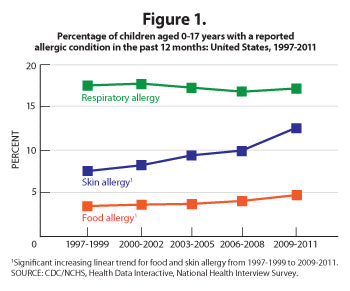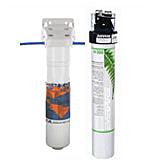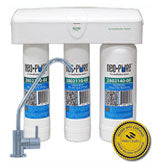Dichlorophenol (DCP) in drinking water may contribute to an increase in food allergies
In 2007, three million children in the United States were reported to have some type of food or digestive allergy. According to the CDC's summary of the National Health Interview Survey, that number had increased to almost six million by the start of 2012. Foods containing milk, eggs, peanuts, tree nuts, fish, shellfish, soy and wheat make up over 90% of food allergies. The rise in childhood food allergies does not appear to be slowing. In a 2012 issue of Annals of Allergy, Asthma and Immunology, researchers argued that this increase seems to be linked to exposure to dichlorophenol.
The US National Health and Nutrition Examination Survey concluded that individuals exposed to dichlorophenol were more likely to have some type of allergic food reaction. Since most consumers do not have the appropriate water filtration system to remove the chlorine and DCP from their tap water, many will continue to be exposed to this harmful chemical.
Reported Increase in Food Allergy Related Illnesses
The Centers for Disease Control have reported that in 1997 3.4% of the children under 18 in the United States had some type of food allergy. By 2011 the number had risen to 5.1% (fig. 1).
Children with food allergies are two to four times more likely to have other conditions, including asthma. Respiratory problems, when combined with food allergies, can become even more life-threatening and may have contributed to the significant increase in hospitalizations related to food allergies.
In the year 2000, hospitals recieved an average of 2,600 patients due to food allergies (fig. 2). In 2003, that number increased to 4,100, and in 2006, it more than doubled to 9,500.


How Does Dichlorophenol (DCP) Get Into the Human Body?
A person can be exposed to dichlorophenol in two ways. First, the chemical is a key ingredient used in formulating chemical pesticides throughout the agricultural industry. Research that has linked the development of food allergies with DCP has found that people are primarily exposed to dichlorophenol through unwashed produce. Drinking water is the second source of exposure drinking. Approximately 90% of America's city and county municipalities use chlorine to disinfect drinking water before sending it out to homes and businesses. Unlike chlorine, dichlorophenol is not added to the water during treatment; instead, it is a by-product of the chlorine used during the disinfection stage.

Carbon based water filters, on average, are only effective for six months. In order to keep your system filtering DCPs and other contaminants, they should be changed at regular intervals.
Water Filtration Options for
Reducing Dichlorophenol
Dichlorophenol consists of two chlorine molecules and one phenol, also known as carbolic acid, which is an organic compound. This compound can be absorbed almost instantly by a point of use carbon water filter. However, DCP is rarely the only chemical contaminant found in tap water. For other dangerous chemicals like fluoride, nitrates, and phosphate, use a higher level water filtration system.
 Carbon Filtration Systems Carbon Filtration SystemsActivated carbon filter and block carbon water filter systems are used to remove specific contaminants including DCPs from water and to give water a better taste. 
|
 Ultrafiltration Water Purfication Systems Ultrafiltration Water Purfication SystemsUF water systems offer more comprehensive water filtration reducing bacteria, viruses, lead, and other chemical compounds. 
|
 Reverse Osmosis Filter Systems Reverse Osmosis Filter SystemsAn RO water filtration system will reduce a wide array of contaminates such as fluoride, pesticides, benzene, mercury, arsenic, pesticides, and more. 
|
Since no specific testing parameters or data from WQA or NSF about DCPs exist, we asked one of our Senior Certified Water Specialist (CWS VI) for advice about water filtering options. As with any water filtration system, the influent levels of DCP along with the flow rate and contact time with filter media is crucial in determining actual reduction rates.
